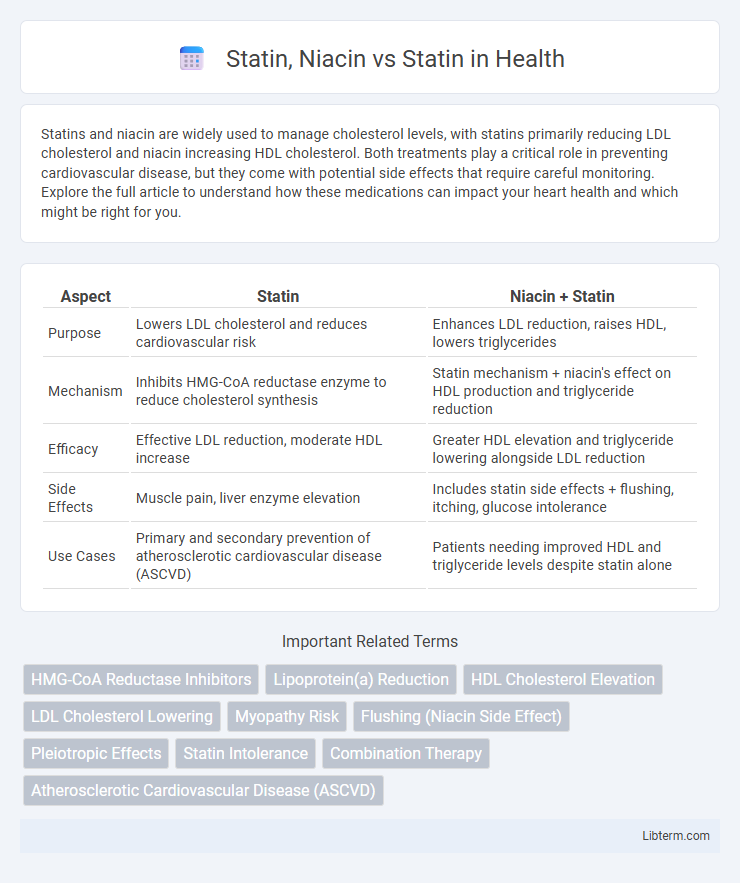Statins and niacin are widely used to manage cholesterol levels, with statins primarily reducing LDL cholesterol and niacin increasing HDL cholesterol. Both treatments play a critical role in preventing cardiovascular disease, but they come with potential side effects that require careful monitoring. Explore the full article to understand how these medications can impact your heart health and which might be right for you.
Table of Comparison
| Aspect | Statin | Niacin + Statin |
|---|---|---|
| Purpose | Lowers LDL cholesterol and reduces cardiovascular risk | Enhances LDL reduction, raises HDL, lowers triglycerides |
| Mechanism | Inhibits HMG-CoA reductase enzyme to reduce cholesterol synthesis | Statin mechanism + niacin's effect on HDL production and triglyceride reduction |
| Efficacy | Effective LDL reduction, moderate HDL increase | Greater HDL elevation and triglyceride lowering alongside LDL reduction |
| Side Effects | Muscle pain, liver enzyme elevation | Includes statin side effects + flushing, itching, glucose intolerance |
| Use Cases | Primary and secondary prevention of atherosclerotic cardiovascular disease (ASCVD) | Patients needing improved HDL and triglyceride levels despite statin alone |
Introduction to Statins and Niacin
Statins are lipid-lowering medications that inhibit HMG-CoA reductase, effectively reducing LDL cholesterol and cardiovascular risk. Niacin, or vitamin B3, lowers LDL cholesterol and triglycerides while raising HDL cholesterol by inhibiting hepatic diacylglycerol acyltransferase-2. Statins primarily target cholesterol synthesis, whereas niacin modulates lipid profiles through multiple metabolic pathways, offering complementary but distinct therapeutic benefits.
How Statins Work: Mechanism of Action
Statins work by inhibiting HMG-CoA reductase, the key enzyme in cholesterol biosynthesis, which reduces the liver's cholesterol production and increases LDL receptor expression to clear LDL cholesterol from the bloodstream. Niacin, unlike statins, primarily reduces lipoprotein(a) and triglycerides while modestly raising HDL cholesterol but does not significantly block cholesterol synthesis. Combining statins with niacin can enhance lipid profile improvements, but statins remain the primary therapy due to their potent mechanism targeting cholesterol synthesis and LDL reduction.
How Niacin Works: Mechanism of Action
Niacin works by inhibiting hepatic diacylglycerol acyltransferase-2, reducing triglyceride synthesis and lowering very low-density lipoprotein (VLDL) production, which in turn decreases low-density lipoprotein (LDL) cholesterol. Statins primarily inhibit HMG-CoA reductase, a key enzyme in cholesterol biosynthesis, leading to increased LDL receptor expression and enhanced clearance of LDL cholesterol from the bloodstream. Combining niacin with statins targets lipid profiles through complementary mechanisms, maximizing reductions in LDL cholesterol, triglycerides, and increasing high-density lipoprotein (HDL) cholesterol.
Effectiveness of Statins in Lowering Cholesterol
Statins are highly effective in lowering low-density lipoprotein (LDL) cholesterol, reducing cardiovascular events by up to 30-50%. Combining statins with niacin can further increase high-density lipoprotein (HDL) cholesterol levels but does not significantly enhance LDL reduction beyond statin monotherapy. Clinical trials consistently show statins as the primary treatment for cholesterol management due to their proven impact on reducing heart attack and stroke risk.
Effectiveness of Niacin in Managing Cholesterol
Niacin effectively raises high-density lipoprotein (HDL) cholesterol while also lowering low-density lipoprotein (LDL) cholesterol and triglycerides, complementing statin therapy. Statins primarily reduce LDL cholesterol by inhibiting HMG-CoA reductase, making them the first-line treatment for atherosclerotic cardiovascular disease. Combining niacin with statins can enhance lipid profile improvements but requires monitoring for potential side effects like hepatotoxicity and glucose intolerance.
Statin vs Niacin: Benefits and Limitations
Statins effectively lower LDL cholesterol by inhibiting HMG-CoA reductase, reducing cardiovascular events with proven outcome benefits. Niacin primarily raises HDL cholesterol and lowers triglycerides but shows limited impact on reducing major adverse cardiovascular events compared to statins. While statins are preferred for their robust evidence in lowering LDL and improving heart health, niacin's benefits are constrained by side effects like flushing and limited additional cardiovascular protection.
Side Effects and Safety Profile: Statins
Statins are widely prescribed for lowering LDL cholesterol and reducing cardiovascular risk, with side effects primarily including muscle pain, elevated liver enzymes, and a small risk of diabetes onset. Niacin, when combined with statins, can increase the risk of flushing, gastrointestinal upset, and liver toxicity, which raises concerns about long-term safety. Clinical studies indicate statin monotherapy generally has a more favorable safety profile compared to combination therapy, emphasizing the importance of monitoring liver function and muscle symptoms during treatment.
Side Effects and Safety Profile: Niacin
Niacin, often compared with statins, presents a distinct side effect profile marked by flushing, itching, gastrointestinal discomfort, and potential liver toxicity at high doses, unlike statins which primarily risk muscle-related issues and rare liver enzyme elevations. Niacin's safety concerns include increases in blood sugar levels and the risk of gout, requiring cautious use in diabetic and susceptible patients. Statins generally have a more favorable and well-studied safety profile, making them the preferred choice for long-term cholesterol management in most cases.
Statin, Niacin, or Both: Choosing the Right Therapy
Statins effectively lower LDL cholesterol and reduce cardiovascular risk, making them the first-line therapy for hyperlipidemia. Niacin primarily raises HDL cholesterol and lowers triglycerides but has limited impact on cardiovascular outcomes when used alone or combined with statins. Choosing the right therapy depends on individual lipid profiles and risk factors; statins remain the cornerstone, while niacin may be considered for patients needing additional HDL elevation or triglyceride reduction.
Current Guidelines and Expert Recommendations
Current guidelines recommend statins as the first-line therapy for managing dyslipidemia due to their robust evidence in reducing cardiovascular events, while niacin is no longer routinely advised because of limited incremental benefit and potential adverse effects. Expert recommendations emphasize statin monotherapy or combination with ezetimibe over niacin, particularly given recent large-scale trials demonstrating minimal additional risk reduction with niacin added to statins. Niacin may be reserved for select patients with severe hypertriglyceridemia or low HDL-C unresponsive to statins, but routine use alongside statins is discouraged in contemporary lipid management protocols.
Statin, Niacin Infographic

 libterm.com
libterm.com